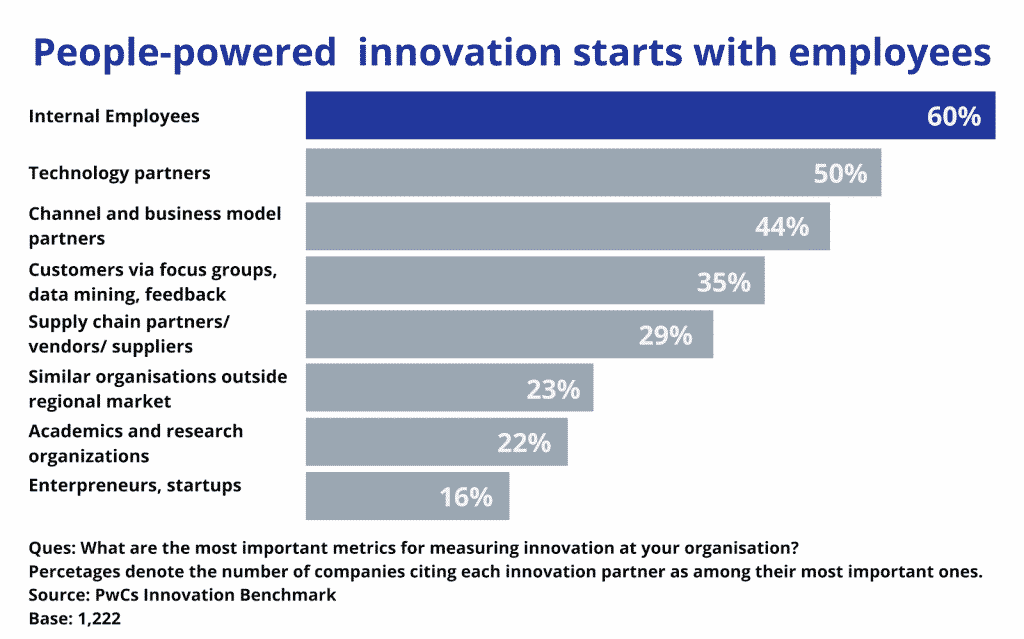Innovation is a powerful buzzword. Business leaders use it in their mantras. Executives promise it to their stakeholders. Managers ask it of their staff.
Despite the popularity of “innovation” as a buzzword, it remains an elusive and abstract idea for many leaders. Not everyone is going to invent a groundbreaking product, but you may feel that that is exactly what innovation is.
It’s time to break it to you: innovation is not invention.
So what is innovation, if not the invention of new and exciting products?
To use a real-world example, think of the increased use of video calls online in the last year. Video calling technology already existed, but the pandemic meant that it became a necessity for all companies to invest in video calling technology.
The first attempt at commercializing video call technology in the 1970s was a failure. Some companies have been using teleconferencing tech for remote meetings for decades. So why did video calling become the norm in 2020?
The companies that lead the way in video calling technology are not made up of the inventors of the video calling tech. Instead, they are full of innovators who offered new, streamlined, and exciting ways to use video calling.
Innovation is about new ideas and change from the bottom up. This is fostered in workplaces with a strong culture of innovation.
What Does a Culture of Innovation Look Like?
You might imagine a “culture of innovation” as existing within a company that is always delivering world-changing ideas, products, or services. But that is just the end goal of innovation.
Companies with a strong innovation culture are those that nurture independent, creative, and mold-breaking thinking in their employees. It is from this culture that new ideas, products, and services are generated.
When leading a team of employees, it’s easy to focus on workplace productivity above all else. As leaders, we have targets to hit and expectations to meet. Whilst productivity is important, cultivating a culture of innovation will make your team stand out and, ultimately, contribute the most value to your business.
So how do you encourage a culture of innovation? Unfortunately, it’s not as simple as telling your staff to “innovate!”. In fact, the Harvard Business Review suggests that many employees dislike the term completely.
Fortunately, there are some powerful tips for fostering an innovative culture amongst your team that, in the long run, your employees will thank you for.
Put Employee Voices First

In 2004, Google implemented their 20% time policy. This encouraged employees to use 20% of their paid time to work on personal projects. It is thanks to side project initiatives like Google’s that we have innovative services like Gmail, Twitter, and Groupon.
In essence, side project initiatives emphasize the value of employee voices in the workplace. And even if you aren’t able to allot 20% of your team’s time to side projects, there are other ways you can put your employees’ voices first.
Meetings, whether they’re online or face-to-face, should begin and end with listening, giving the opportunity for those you lead to speak and center their voices at every opportunity.
Prioritizing your employees’ voices can also grow into tangible employee engagement strategies. These could include regular, company-wide discussions that encourage contribution from all levels or targeted employee experience surveys. But these techniques will only work if you back them up with small but regular signs that you recognize your team’s voice.
Define Your Company Culture

As we can see from the graph above, a lack of defined company culture is often cited as an inhibitor of innovation by employees. Why is this?
An employee may know their company’s products and services well, but innovation is all about introducing something new. This is impossible if employees do not have a strong sense of a company’s culture - namely, its values, goals, and attitudes.
Defining your company culture can be achieved in many ways. It could start with finding out how to create a handbook that effectively communicates your company’s values and goals from the outset. It can also be communicated through other channels and activities - such as workshops, competitions, daily workplace rituals, and encouraging employees to socialize outside of meetings.
Digitize Open Communication
Writing for Forbes, innovation guru Alex Goryachev states that “innovation is communication”. Open communication between leaders and their teams is a sign of a great workplace environment, and it also encourages innovation.
The first step in encouraging open communication is to ensure your team can contact you with ease. Now that so many of us are not working in a traditional office environment, the idea of an “open-door policy” becomes frustratingly abstract.
There are ways to leverage technology to maintain and even improve communication between staff. Using tech such as instant messaging and regular team video catch-ups, are great ways to streamline the communication lines between your team.
The next step, however, is to ensure that you are communicating openly and with ease with your team. This is another opportunity to make the most of tech-savvy business communication tools, but it ultimately comes down to whether or not your team feels listened to. Show your team that you respond well to their questions, concerns, and feedback and, most importantly, act on them.
Embrace Diversity

It may sound obvious, but a range of voices, backgrounds, and perspectives drive innovation. This is why leaders hoping to cultivate a culture of innovation need to embrace diversity.
The first step is, of course, prioritizing diversity throughout your recruitment process. Ask yourself what voices are missing from your team and bear this in mind when you assess potential candidates.
Diversity also needs to be fully embraced by your team. Developing a diversity training programme will not only improve your company culture and help raise awareness amongst your team. It will also provide a space for innovative perspectives to be voiced.
Eliminate Fear of Failure
Even if you have fantastic communication within your team, this may not be enough to eliminate the fear of failure that many employees feel. Dr Alan Kuyatt of the University of Maryland argues that it is often “the fear of management’s negative reaction to failures that keeps people from bringing up new ideas or pointing out potential problems that could benefit from innovation”.
How can leaders eliminate the fear of failure and encourage innovation? This must be done on an individual and a team level. Getting each member of your team to use a self-assessment tool is an effective way to alert them to their strengths and tailor personal training opportunities for them.
The fear of failure needs to be removed on a team level too. Running remote team building activities that encourage creativity, brainstorming, and independent thinking will foster the same ways of thinking and innovating when at work.
Persevere
In one of the most inspiring feats of human innovation in our lifetime, NASA’s rover, Perseverance, landed on Mars in February 2021. The name of the rover reminds us that innovation doesn’t happen overnight - it is the result of perseverance.

When aiming for innovation, we must remember Bill Buxton’s influential “long nose of innovation”. Buxton writes, “the bulk of innovation behind the latest ‘wow’ moment (multi-touch on the iPhone, for example) is also low-amplitude and takes place over a long period — but well before the ‘new’ idea has become generally known, much less reached the tipping point.”
This doesn’t mean you should give up on inspiring innovation - in fact, it reminds us how vital taking small but powerful steps in cultivating a culture of innovation really is. Even if you are not creating space exploration technology, perseverance is still key to innovation at any level.
Final Thoughts
Encouraging innovation within a team isn’t a simple task. If it were, everyone would be rolling out exciting and innovative ideas. Nonetheless, this article has suggested some powerful tips for cultivating a culture of innovation.
Centering employee voices, a well-defined company culture, open communication, and diversity all contribute towards innovation. Remember that innovation isn’t instantaneous. Each of these tips requires commitment and perseverance from the leaders who implement them - and the rewards can be tremendous.

.jpg?width=1600&name=62066e64b1790ab5fcad7b42_culture%20of%20innovation%20(1).jpg)





